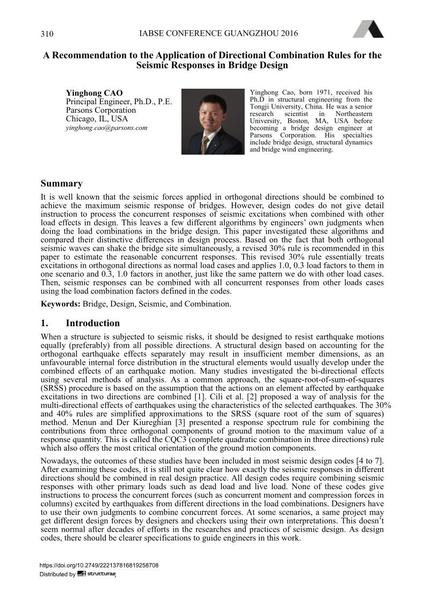A Recommendation to the Application of Directional Combination Rules for the Seismic Responses in Bridge Design

|
|
|||||||||||
Détails bibliographiques
| Auteur(s): |
Yinghong Cao
|
||||
|---|---|---|---|---|---|
| Médium: | papier de conférence | ||||
| Langue(s): | anglais | ||||
| Conférence: | IABSE Conference: Bridges and Structures Sustainability - Seeking Intelligent Solutions, Guangzhou, China, 8-11 May 2016 | ||||
| Publié dans: | IABSE Conference, Guangzhou, China, 8 – 11 May 2016 | ||||
|
|||||
| Page(s): | 310-318 | ||||
| Nombre total de pages (du PDF): | 9 | ||||
| Année: | 2016 | ||||
| DOI: | 10.2749/222137816819258708 | ||||
| Abstrait: |
It is well known that the seismic forces applied in orthogonal directions should be combined to achieve the maximum seismic response of bridges. However, design codes do not give detail instruction to process the concurrent responses of seismic excitations when combined with other load effects in design. This leaves a few different algorithms by engineers’ own judgments when doing the load combinations in the bridge design. This paper investigated these algorithms and compared their distinctive differences in design process. Based on the fact that both orthogonal seismic waves can shake the bridge site simultaneously, a revised 30% rule is recommended in this paper to estimate the reasonable concurrent responses. This revised 30% rule essentially treats excitations in orthogonal directions as normal load cases and applies 1.0, 0.3 load factors to them in one scenario and 0.3, 1.0 factors in another, just like the same pattern we do with other load cases. Then, seismic responses can be combined with all concurrent responses from other loads cases using the load combination factors defined in the codes. |
||||
| Mots-clé: |
design pont
|
||||
